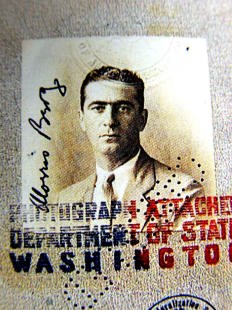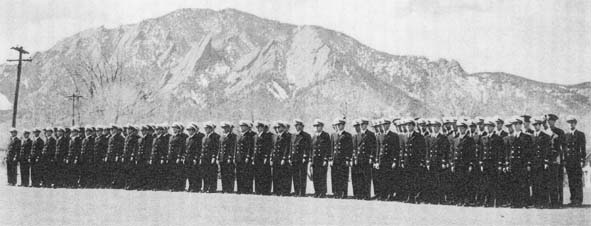Yamaguchi Tamon
Yamaguchi Tamon organized espionage network in US, when he was a navel attache of Japanese embassy in 1935. He agreed with a German attache who cooperated each other.
Yamaguchi Tamon
Sanematsu Yuzuru
Sanematsu Yuzuru was a naval attache of Japanese embassy in Washington DC. He got an information in 1940. An attache of Italian Navy told him that RN might have 'a secret weapon' that warships could shoot in the dark midnight without a search light. He inquired an IJN officer in New York. The officer replied that battleships, aircraft carriers and heavy cruisers have such antennas on the top of the bridges.
He breathed a word about Japanese American's captivity, when the Pacific War broke out. IJN had built espionage network in US for a long time. He came back on a wartime exchange ship. On seeing lights of rooms of Ministry of IJN turn off at 6 pm, he also sighed, lights of Ministry of USN did not turned off till midnight.
Although Sanematsu of 3rd department of Gunreibu insisted that USN would invade Mariana, 1st section of operation misjudged. Gunreib admitted 3rd section was right on 30 January 1944.[4]
Signal Intelligence
IJN was picking up US signal on radio. The most concern was USAAF BG just before Pearl habor attack. These signals were listened at Oowada tsushintai of which troops was increased from 60 to 400 in the end of the war.
6th tsushintai of Martial Islands warned USN action before a day, when USS Enterprise and Yorktown air raided there on 1 February 1942. But head quater of 4th fleet pay no warning. Head quater of 6th Naval base at Truk Islands held a drinking party the day before.[6]
An intelligence officer of GF correctly thought USN operation would act Mariana. However, operation department of Gunreibu thought Biaku as main advancing route, so moved most of landing aircraft from Mariana to Palau etc.[7]
IJN could not decipher USN strip cipher, though IJN organized a special task group.[5] So IJN depended on signal intelligence. How could IJN signal intelligence predict USN operation? IJN gathered publicized information from broadcast, newspapapers and magazines. They contained newly launched aircraft carriers and battleships and damage and replenishment of US Army and Marines divisions. Section 5 analyzed these information, air raids, bombardment, telegrams and telegram lenght of submarines. Almost USN operaions were able to predict. Auxiliary officers from universities analyzed them.
Why did not IJN rely on signal intelligence?
Operation department of IJN did not trust the intelligence activity. Genda reflected that they were dogmatic. Simply I think that IJN chief commanders were less intelligent. They held meetings and heard staff opinions well, and adopted always opinion of operation department. That all. Staff like Genda controlled IJN operation after Yamamoto was assasinated. While USN chief commanders used HYPO and relied on the intelligence. IJN did not find that USN read IJN cipher till the end of the Pacific War.
Intelligence of Army General Staff Office against Russia and Germany were 5th section and 16th each. In fevering battle of Germany and Russia, both section argued in Sep 1942. the 5th analyzed numbers of freighters and aircraft via Siberia from US correct, and assured Germany would not win. 5th section had already informed advantage of Russia in August 1941[1].
Shiraki of 5th section assured in February 1945, Russia would will invade in August or September. But 2nd section of war operation controlled Army General Staff Office entirelly.
 |
Suma Yakichiro ( 1892-1970 ) was a diplomat on China at first. Suma established cabinet intelligence department in 1937. He also established Tokikan in Japanese embassy of Spain in 1940. Suma hired a jewish Spanish as a chief who organized agents in Washington DC, NYC, LA, Sandiego, etc half a year later. Suma made espionage network in North America, Australia and Dakar in January 1941. The information was transfered via Mexico to Spain. The organization got information about nuke project. However, US read messages from embassy to Japan, two agents relative to the nuke test were killed by US official in the US.
Sugoi yatura ga yattekita
I was impressed that US focused to Japanese aircraft manufaturing. I understood that destroying of Musashino Seisakusyo of Nakajima was not a simple military target but a symbolic military target. Hansel of UAAF could not destroy the target. The target was destroyed by a USN air raid in a day. As matter of fact, production of aircraft of Musashino was very lowered by the factory evacuation. It was unlucky to Hansel.
The American Council on Japan (ACJ) was a small, loosely knit group organized in 1948 to reverse American policy in the Japanese occupation. Its spearhead was Harry F. Kern, foreign editor of Newsweek ; James Lee Kauffman, Eugene Dooman, former Ambassador Joseph Grew, and former Undersecretary of State William R. Castle were the organizers.
While Military Intelligence Service Language School adopted a lot of Japanese Americans as radio interceptors and interrogators.[9]
Oka Shohei (1909-1988) was an excellent scholar of French literature. Aida Yuji (1916-1997) was a western historian. Both were drafted as soldiers. IJA seems not to have used our intellecturals effectively. A lot of US students volunteered in breaking war at once. However, few Japanese students volunteered and the rest of them were enforced to draft in December 1943.
USN captured code books from sunk IJN submarine I-1 and I-124. I-124 was sunk in January 1942 near Port Darwin. While Tang ( SS-306 ) sank near Taiwan and USS Grenadier ( SS-210 ) sank near Penag, IJN might get a code book from them, but it failed.[11] US Marines invaded a coral of Makin from SS-168 Nautilus, one of aim was to capture code book. UK and US were very eager to steal code books or cipher machines of enemies, German and Japanese authors of war books refer to the fact. It reminds me of tradition since Walsingham ( 1532-1590 ).
A code book and an operation book called 'Z' of IJN happened to be in the hand of USN, when 2 Emily bailed out sea in March 1944, when staffs of the grand fleet were fleeing. IJN called its incident Otsu jiken.
F-13 flew over Japan and took more than 13,000 photos in 1944. Looking up them, Intelligence of 20th AAF found a factory of tetraethyl lead in a town[2]. The tetraethyl lead was material which US banned to export by embargo. It was used in gasoline as an anti-knocking agent. Intelligence of Washington informed the AAF a name of the town. Is it true? Simply US surveyed such information like intelligence activity of Moe Berg, I guess.
Gunzo, p173-177 No65
[1] Hori, p50-53
[2] B-29, p195
[3] Nakajima, p273
[4] Genda, p264-265
[5] Nakajima, p264
[6] Chihaya, p208-211
[7] Nakajima, p186-187
[8] St Luke's International Hospital
[9] Intelligence wo kaita IJA&N
[10] US Navy Japanese/Oriental Language School Archival Project
[11] Yoshida, p75

aboutMe
© 2007-2011 Enoki Sensor All Rights Reserved

